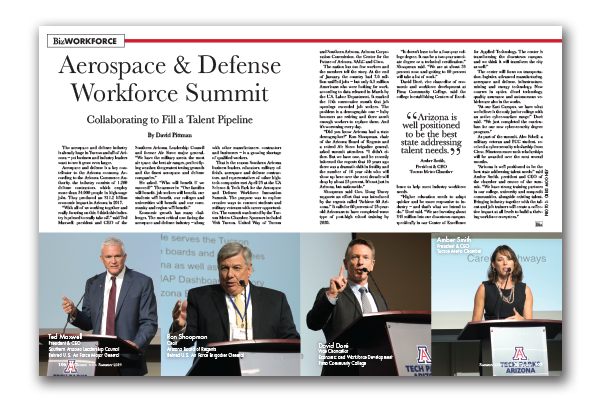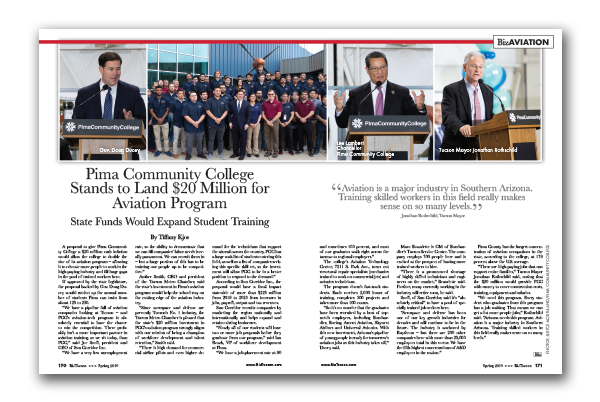
Morris Air National Guard Base
By David Pittman –
Founder of 162nd Wing Honored in Naming Ceremony
History first happens in the present – but later can be revisited, recognized, recovered and revered.
That was demonstrated at a gathering of about 350 people at a November ceremony renaming the Air National Guard Base at Tucson International Airport the “Morris Air National Guard Base” as a posthumous honor to Brig. Gen. Donald E. Morris.
Morris was the single most influential person in founding, building and growing the 162nd Wing in Tucson into one of the largest and most successful Air National Guard units in the nation. The base has more than 80 jets and nearly 1,900 personnel. It is the second largest Air National Guard Wing in the nation.
“Gen. Morris was so influential in creating this unit and shaping it into what it has become today,” said Brig. Gen. Andrew J. MacDonald, the current commander of the Morris Air National Guard Base. “I am very appreciative of the legacy of the man who brought us here – and that was Gen. Morris.”
In 1956, Morris, then 33, was directed by the late U.S. Sen. Barry Goldwater to form the 152nd Fighter Interceptor Squadron, the precursor to the 162nd Fighter Wing, and make it flourish. Goldwater, who served as a colonel in the Air Guard, had already established a similar squadron, the 161st at Sky Harbor Airport in Phoenix, and instructed Morris to do the same in Tucson.
Morris, who served during World War II and the Korean War, had 15 years of military service under his belt and had risen to the rank of major before moving from Goldwater’s Phoenix unit to the Old Pueblo. Morris initially brought only eight airmen with him to Tucson, and the base’s early facilities consisted of an old farmhouse; a small, dirt-floor hangar, and a couple of F-86 Sabre jets. Within a few weeks, Morris built the squadron to 15 officers and 80 enlisted men. Two years later, the base had 570 members. The 162nd Fighter Wing was off and running.
Naming the installation Morris Air National Guard Base “honors a military leader who put his heart and soul into making the 162nd Wing what it is today,” said Robert Medler, president of the 162nd Air Guardians, a civilian group that provides support to the installation and the men and women who serve there. “It is way past due time to name this the Morris Air National Guard Base.”
Under Morris’ command, the Air Guard at Tucson International Airport was among the earliest to fly the F-100 Super Sabre, the first operational plane in the Air Force capable of breaking the sound barrier.
Major Gen. (Retired) Wess P. Chambers – the second commander at the 162nd Wing, a close friend to Morris and one of the original eight airmen who set foot on the TUS Guard site – said that early in his command, Morris made regular outreach efforts to build connections with community leaders. Chambers said Morris also traveled frequently to recruit new Guard members. Morris became known as “Mr. Tucson Air National Guard.” He also was referred to as “Mo.”
During Morris’ tenure as commander of the 162nd, TUS was home to various aircraft, including F-86s, F-84s, F-100s and F-102s. During the Morris era, the Guard base underwent numerous upgrades and construction projects to accommodate an ever-changing flying mission and constant growth.
Morris’ run as base commander, which stretched from 1956 through 1971, laid a strong foundation for the Arizona Guard installation.
It was well-known that Morris thought the unit’s primary purpose would someday be pilot training. His vision became reality near the end of his service as base commander during the Vietnam War. It was then that the Air Force asked Morris’ group to change its mission from F-102 air alert to F-100 fighter training. The change proved pivotal, resulting in 47 years of training programs (and still counting) conducted at the base.
The primary mission at the installation has evolved into F-16 pilot training. That training is provided not only to U.S. pilots, but those from foreign countries. For that reason, the 162nd is considered “the face of the U.S. Air Force around the world” because it has trained jet pilots from more than 25 allied countries.
However, the Wing operates other missions as well, including:
• A remotely piloted aircraft, or drone, program, which flies daily combat missions in the Middle East and provides troops on the ground with intelligence, surveillance and reconnaissance.
• A homeland defense detachment with fully loaded F-16s and the pilots to fly them. They are ready to react to any threat or emergency – be it military attack, terrorism or a lost airliner – at a moment’s notice 24/7.
By 1971, Morris had earned the rank of colonel and the Tucson Air Guard unit had swelled to 1,000 members. Later that year, he left the unit he started from scratch and raised from a dirt-floor hangar.
Over the span of his 39-year military career Morris compiled 9,000 flying hours, 5,200 of which were in jet fighters. His major awards included the Distinguished Service Medal, the Legion of Merit and the Air Force’s Order of the Sword, which is presented by noncommissioned officers to individuals held in high esteem.
Morris retired in 1983 and chose to return to Tucson, which Chambers said was a town his pal loved “where he still had many friends.” Chambers also said Morris’ life and work were all about family. His son, Don Morris Jr., and his grandson, John Morris, both served in the 162nd, just as thousands of other Tucson fathers, mothers, sons and daughters have done over the 62-year history of what is now Morris Air National Guard Base.
MacDonald said the shift to Morris Air National Guard Base actually isn’t a renaming at all.
“This base really hadn’t been named before. People referred to it as the Arizona Air National Guard Base, but that really isn’t a name,” he said. “So, the dedication ceremony is actually the first time the base was named.”
Morris, who crafted one of Arizona’s most impressive military legacies ever, died in 2016 at age 92.





